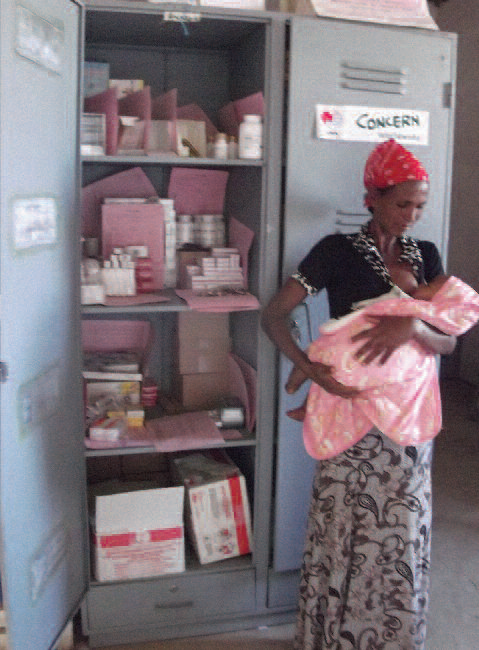Overcoming RUTF storage challenges in Tigray, northern Ethiopia
 Lulseged Tolla, Charlotte Walford and Pankaj Kumar, Concern Worldwide Ethiopia
Lulseged Tolla, Charlotte Walford and Pankaj Kumar, Concern Worldwide Ethiopia
Lulseged Tolla has been working with Concern Worldwide since 2011 on CMAM and IYCF programmes.
Pankaj Kumar has over four years experience with Concern Worldwide in Ethiopia and has worked in a number of other African countries.
Charlotte Walford has been working with Concern Worldwide Ethiopia since September 2012 supporting their CMAM and IYCF programmes.
Introduction
The 2011 Ethiopian Demographic and Health Survey showed that nationally, 9.7% of children under five years old were wasted and 44.4% stunted. In Tigray Region specifically, levels of undernutrition in this age group are higher than average: 10.3% wasted and 51.4% stunted. A number of large-scale emergency and development programmes are being implemented by the Government and key stakeholders (NGOs & the United Nations) to support improved health and nutrition.
Since 2007, Concern Worldwide Ethiopia has been providing support to Tigray Region in northern Ethiopia for the treatment of acute malnutrition through an outpatient therapeutic care programme (OTP), which has now been integrated into service delivery at health facilities. In August 2009, with funding from the World Bank, the interventions were scaled-up in five woredas (districts) with high rates of acute malnutrition.
During the past four years of implementing OTP activities, it was observed that most health posts (HPs) had problems with the proper storage of RUTF and other OTP supplies. Concern Worldwide and the local government conducted an assessment of the storage situation to identify the barriers to proper storage and to develop practical and affordable solutions.
 Assessment method
Assessment method
A qualitative assessment consisting of 1) key informant interviews with Health Extension Workers (HEWs) and health professionals (health extension programme supervisors and woreda health office nutrition experts) and 2) team observation was undertaken in 72 HPs in five woredas in the region.
Assessment results
Interviews and observation in the HPs identified two main issues with the storage of RUTF:
- Open storage. Most health posts consist of one room, as they were intended to only provide preventive health activities. Although recently constructed, there is often no appropriate storage space for RUTF and other OTP supplies. RUTF was rarely stored in a self-contained locked unit or separate room, as recommended for other medical supplies. RUTF was kept in a storeroom with other medical and non-medical supplies in 42% of HPs. Of the remaining HPs, 37% stored RUTF on the floor or on a bench, 14% in either locked or unlocked cabinets, whilst 7% stored RUTF in the examination room, in bags or at nearby health centres.
- Rodents and insects. Rats were a problem in 50% of HPs and small insects (weevils) in 4%. This was largely due to the presence of openings/holes around the edges of windows, doors or under the roof.
Programme Activities
To improve storage at the HPs, a number of changes were put in place:
- An appropriate, lockable metal cabinet to store RUTF and other OTP supplies was designed, manufactured and delivered to 90 HPs. These cabinets were initially installed in 2012 and follow up during monitoring visit revealed 100% utilization. HEWs reported no loss of RUTF due to rodents, insects or theft with the use of the cabinets. The cabinets are projected to have a shelf life of more than 15 years. The cost of one metal cabinet is approximately 450 USD.
- Health Post staff were also trained on how best to store RUTF, medications, equipment and supplies for OTP outreach, based on Ethiopia’s national protocol for the management of SAM.
Further recommendations
To improve storage conditions of RUTF more widely in Ethiopia, the following activities are recommended:
- Develop clear policy guidelines regarding RUTF handling and storage in collaboration with government
- Provide awareness for HEWs, supervisors and woreda focal person on the importance of RUTF as a medical supply, rather than a food item, to ensure proper storage status
- HEWs should receive training (pre-service or in-service) on logistics management
- Adequate, locked storage facilities for RUTF should be provided as standard either in the form of a locked cabinet or as an additional, locked room. Including such a cabinet for nutritional supplies is now considered best practice by development partners and the Government of Ethiopia as a part of National Nutrition Programme.
For more information, please contact Pankaj Kumar, pankaj.kumar@concern.net.

